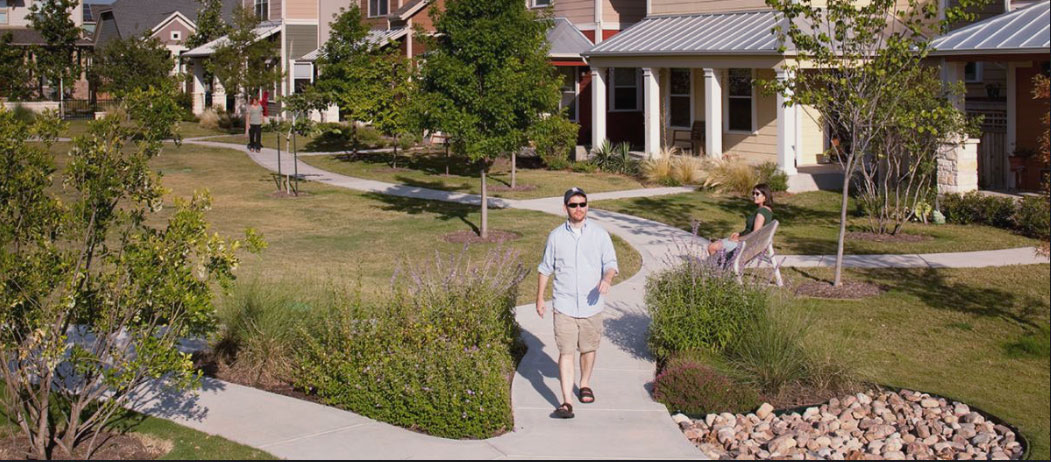Study finds Mueller development raises residents’ physical activity

Xuemei Zhu

Chanam Lee

Zhipeng Lu

George Mann
Residents of the pedestrian-oriented, activity-friendly Mueller development in Austin walked more, had improved social interactions with their neighbors and perceived more neighborhood cohesion than they did in their previous neighborhood, according to a [study] (http://www.sciencedirect.com/science/article/pii/S0091743514003041) led by Xuemei Zhu, Texas A&M associate professor of architecture.
The study’s findings, said Zhu, show that Mueller’s design, which includes narrow, tree-lined streets with businesses and green spaces within short walking distance, has increased the physical activity and “neighborly” interactions of its residents, which was the intent of the development’s designers.
“The study also revealed significant reductions in residents’ driving, suggesting that walkable communities can also deliver important environmental benefits by reducing fuel consumption and environmental pollution,” said Zhu, who conducted the study with Chanam Lee, associate professor of landscape architecture, Zhipeng Lu, architecture lecturer and George Mann, professor of architecture. Zhu, Lee, Lu and Mann are part of the [Design Research for Active Living Team] (http://research.arch.tamu.edu/activeliving/) in the [Center for Health Systems & Design] (http://chsd.arch.tamu.edu/) at Texas A&M’s College of Architecture.
The findings are based on data from 449 surveys of Mueller residents who answered questions about their physical activity and sense of community in Mueller and their previous residences.
Mueller, a planned development approximately 5 miles from downtown Austin, features many activity-friendly design characteristics, including a mix of high-density residences and small businesses, 140 acres of evenly distributed parks, 13 miles of hike and bike paths and sidewalks lining a grid pattern of interconnected streets. Mueller is also a mixed-income community, with more than 25-percent affordable housing units indistinguishably incorporated with market-rate units.
Residents reported a 40% average increase in walking or biking activities after moving to Mueller. Additionally, 65% of the study respondents noted an increase in physical activity and 48% said their health improved.
Researchers also found that Mueller residents who had previously lived in areas [unfavorable] (https://www.walkscore.com/) to walking showed the most increased physical activity, with the more significant increase among high-risk populations who were inactive in their old neighborhoods or prone to obesity and other potential health risks, said Zhu.
In addition to increased socializing with neighbors on Mueller’s streets and in their homes, the study found that residents perceived Mueller as a more close-knit place than their previous neighborhoods.
Findings from Zhu and her fellow researchers were mentioned in an article posted on the [Scientific American] (http://www.scientificamerican.com/article/architects-place-priority-on-public-health-for-2015/) website. The article also reported a new partnership between the [American Institute of Architects] (http://www.aia.org/advocacy/publicpolicy/index.htm) and design programs at Texas A&M and 10 other universities that will research the relationship between building design, city planning and health.
The study was supported by grants from the AIA and the [Global Obesity Prevention Center] (http://www.jhsph.edu/departments/international-health/the-globe/archive/fall-2011/jhgcco.html) at Johns Hopkins University.
Additional partners in the project included the Texas A&M Health Science Center’s [College of Medicine] (http://medicine.tamhsc.edu/) , the [International Union of Architects’ Public Health Group] (http://www.uia-public-health-group.org/) and city of Austin staff, developers and designers engaged in the Mueller development.
Previous post
Next Post
Tags
- arch gallery
- architecture
- archone gallery
- chsd gallery
- coa gallery
- energy sustainability
- enviro gallery
- landscape architecture & urban planning
- laup gallery
- research
- research gallery
- rss
- sustainability
- transportation
- urban systems
- wellness
Related Posts

HRRC eying how disasters influence food distribution

Oct. 23 symposium spotlighted college, faculty research

Innovative ‘green’ wall features sheet metal, native plants

Oct. 29 symposium spotlights college, faculty research

Summit explored education advances with ‘smart’ cities
Follow Us
Facebook Twitter Vimeo Youtube Flickr RSS
Recent Posts

Planning prof heads study of disaster housing aid

A message from the dean

Former student remembered as expert planner

Leading educator named new head of Architecture Dept.





_thumbnail_small.png)
